- Books Name
- ACME SMART COACHING Biology Book
- Publication
- ACME SMART PUBLICATION
- Course
- CBSE Class 11
- Subject
- Biology
Morphology, Anatomy & Function of Different Systems of
an Annelid, an Insect & an Amphibian
EARTHWORM
Indian Earthworms (Pheretima posthuma)
Phylum : Annelida
Class : Oligochaeta
Genus : Pheretima
Species : posthuma
There are several types of Earthworms. The most common genus of Earthworm is Pheretima in India and Lumbricus in Europe. Pheretima has 500 species, 13 of them are found in India.
Habitat :
Earthworm is reddish brown terrestrial animal which inhabits upper layer of moist soil where it lives inside burrows during day time.
Earthworm inhabits those soils which have abundant organic matter.
An acre of good moist soil can have upto 50,000 animals. Burrow is made by boring and swallowing the soil.
The burrows are vertical or oblique.
They are 30-45 cm deep during moist season but may go as deep as 2 m in summer.
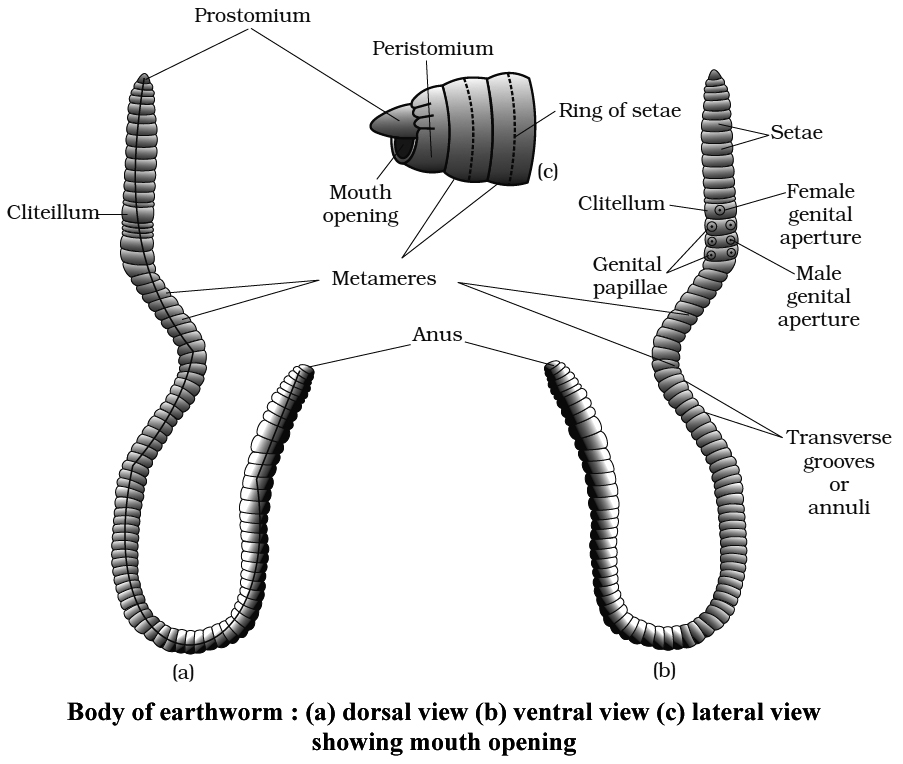
The burrows are lined by debris or mucus secreted by the animals.
The burrow is wider at the base.
During winter the animal drags organic debris into its burrow and plugs the mouth of the burrow.
This keeps the burrow warm.
Even the mouth of the burrow is hidden from view by leaves and small stones.
The area of the burrow can be recognised by faecal pellets called worm castings.
Habit :
Earthworm is nocturnal because it is sensitive to higher light intensities.
It partly creeps out of burrows during night for search of food.
It is only during rainy season that the earthworm comes out of the burrow even during daytime.
After heavy rainfall, they can be seen crawling on the ground in large number.
If the burrow is left, the animal does not re-enter the same.
It digs a new burrow by pushing the body through the soft soil as well as by eating its way through the soil.
The worm keep its skin moist through mucus, coelomic oozings and from moisture of the soil. The animal respires through skin.
The body of earthworm is long cylindrical has about 100-120 segments (metameres). The first segment is called as 'buccal segment' or peristomium which bears a very small terminal opening the mouth.
A small projection is also present which hangs over the cresent shaped mouth and is called prostomium. It serve as a wedge to force open cracks in the soil into which earthworm may crawl. It is sensory in nature.
The skin of earthworm is brown due to the presence of porphyrin pigment and protects the earthworm from UV radiations.
In all the body segments, except the first, last and clitellum, there is a ring of S-shaped setae, embedded in the epidermal pit at the middle of each segment (perichaetine).
Setae are chitinous structures and are not dissolved in KOH.
In the intersegmental grooves of 5/6, 6/7, 7/8, 8/9 segments, 4 pairs of spermathecal pores are present which are the opening of spermathecae.
A thick band of glandular tissue clitellum (cingulum) surrounds segments 14 to 16, forming a thick girdle, its glands secrete mucus and albumin, they also form the cocoon.
On the ventral surface of 18th segment, a pair of male genital apertures are present and on the ventral surface of 14th segment, a median female genital aperture is present.
On the ventral side of each of the 17th and 19th segments, circular raised pairs of genital papillae are present which help in reproduction.
The dorsal surface of body is marked by a dark median mid dorsal line (representing dorsal blood vessel) along the longitudinal axis of the body. The ventral surface is distinguished by the presence of genital openings (pores).
Internal Morphollogy
The body wall of earthworms is thin, soft and slimy. From the surface inwards, it consists of cuticle, epidermis, muscular layers and coelomic epithelium
(1) Cuticle: It is thin and elastic non-cellular protective membrane. It is formed of collagen fibres secreted by underlying epidermis.
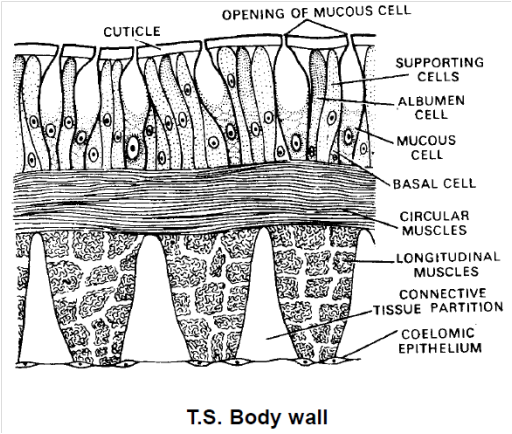
(2) Epidermis: This is a single layer of epithelium of tall, columnar cells which are distinguished into four types as follows :
Supporting cells : Unspecialized epithelial cells that form the major part of the epidermis.
Glandu1lar cells: These are of two types-the more numerous and club-shaped mucus-secreting goblet cells and fewer, narrower albumen cells. The mucus, secreted by these cells, keeps the body wall moist and slimy. It is also used to lubricate and smoothen the walls of burrows.
Basal cells: These are shorter, conical cells wedged in between narrower basal parts of other cells.
Sensory cells: These are narrow, columnar cells occuring, here and there, in small groups. Each sensory cell has small sensory hairs at its free end.
(3) Muscular layer: Beneath the epidermis is the muscullature of body wall. It consists of a thin outer layer of circular and about twice thicker, inner layer of longitudinal muscle fibres. The circular muscle layer is a continuous sheet around the body, but the longitudinal layer is broken into several longitudinal strips or bands, separated from each other by thin connective tissue partitions. These bands appear elliptical or club-shaped in transverse section. Numerous granules of porphyrin pigment are found scattered in circular muscle layer.
(4) Coelomic epithelium: Next to the longitudinal muscle layer is a thin, membrane-like, mesodermal epithelium of flattened, squamous cells. It is the outer envelope of coelomic cavity and hence called parietal or somatic layer of coelomic epithelium or peritonium.
Coelom or Body Cavity
Earthworm has schizocoel type of body cavity.
It lies between the body wall and alimentary canal.
A layer of peritoneum lines both the surfaces, outer parietal in contact with body wall and inner visceral in contact with alimentary canal.
The coelom of first four segments is continuous or undivided.
The coelom is divided by septa from fourth and fifth segment onwards.
The septa lying between segments 5/6, 6/7, 7/8, 8/9 or 9/10 and 10/11 are thick and muscular.
One of the two septa, either between the 8th and 9 th or between 9 th and 10th segments are absent.
The first six septa are cone like and run obliquely backwards from the body wall to the gut wall.
The first nine septa i.e. upto septum 13/14 are without perforations.
The remaining septa beginning from septum 14/15 are perforated by numerous apertures.
Coelomic fluid is milky white and alkaline. It has fluid matrix of watery plasma containing proteins, salts and numerous minute nucleated corpuscles. Corpuscles are of following four types.
(a) Phagocytes: They move like Amoeba and engulf harmful germs.
(b) Leucocytes : These are smaller and fewer. Their function is not fully understood.
(c) Mucocytes: These are elongated, vase like corpuscles, one end forms an expanded fan like structure and the other narrow end contains nucleus. Function of these cells is not known.
(d) Eleocytes : They are formed by mitosis of the yellow cells of the visceral peritoneum. They contain glycogen and fat and distribute their food to various tissues.
Coelomic fluid serves as a hydrostatic skeleton to assist the musculature of body wall in bringing about the locomotion of body. It oozes out upon body surface through dorsal pores, keeping the body wall moist to facilitate respiration and to destroy bacteria and other harmful micro-organism.
Locomotion
The earthworm does not have specialized locomotory organs.
The locomotion is brought about by the circular and longitudinal muscles of the body wall, aided by the chitinous curved setae embedded in the skin.
Due to the contraction of the circular muscles of the anterior end the latter becomes thin, elongated and extends forwards.
At the same time, the setae of the anterior end hold the ground firmly and prevent the animal from slipping backward.
Now the circular muscles of the anterior end relax and the longitudinal muscles contract.
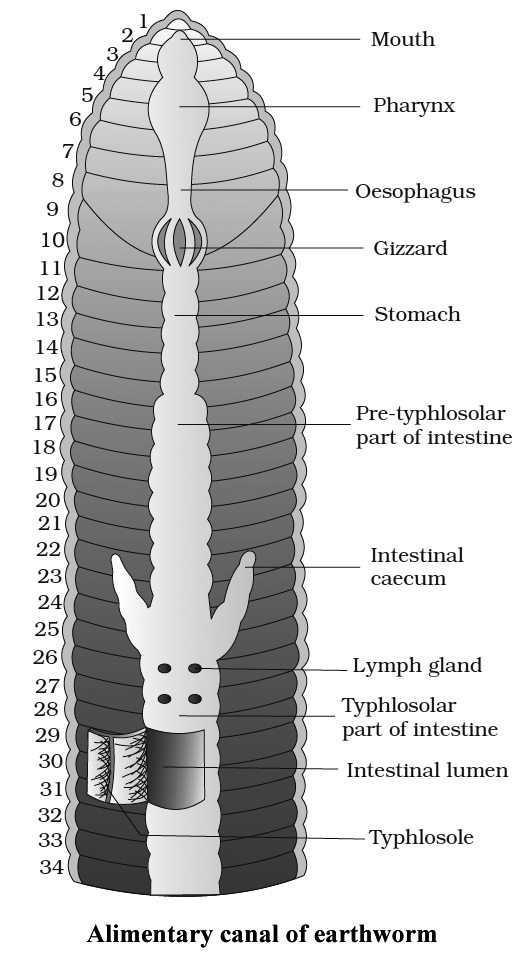
It causes the shortening and thickening of the anterior segments, and thus, the posterior part of the body is pulled ahead.
The process is repeated and the worm is able to move forward with speed. Earthworms move at the rate of about 15 cm per minute.
Alimentary Canal
It is a straight tube and runs between first and last segment of the body.
In 1-3 segments buccal cavity is present, pharynx in 4th segment.
From 5-7 segments oesophagus is present.
Gizzard is present in 8th segment.
From 9-14th segments is a tubular stomach. Calciferous glands are present in the stomach, which produce CaCO3 to neutralise the humic acid.
Intestinestarts from the 15th segment on wards and continues till the last segment.
A pair of shortand conical Intestinal caecae projects from the intestine on the 26th segment. They secrete amylolytic enzyme which digests starch. Other enzymes are lipase, cellulase, invertase etc.
Surrounding the pharynx there are pharyngeal or salivary glands, made of masses of chromophil cells, they produce mucin for the lubrication of the food, and also a proteolytic enzyme which can digest some proteins.
Associated with the intestine are chloragogen cells which are supposed to be excretory in function.
Intestine is divided into
(a) Pre-typhlosolar region from 15 to 26th segment, it has small villi
(b) Typhlosolar region which starts from 27th segment and extends upto 23-25 segments in front of anus. Typhlosole is a large villus as an internal median fold of dorsal wall of intestine. This enhances effective area of absorption after digestion.
(c) Post-typhosolar region: Also known as rectum. It is present in last 23-25 segments and opens to outside through a terminal anus.
Lymph glands: These are white fluffy bodies which are found arranged on either side of the dorsal vessel from 26th segment and extend to the successive segments. These glands are believed to produce phagocytes of the coelomic fluid.
Circulatory system
Earthworm is first to evolve a closed circulatory system in the evolution of animals.
The respiratory pigment is haemoglobin which remains dissolved in the plasma, RBC are absent.
Blood glands are present on 4, 5 and 6th segments, they produce blood cells and haemoglobin.
There are 2 main blood vessels.
Dorsal vessel is the largest vessel and blood flows forwards from postrior end to anterior end. They have contractile wall, and valves are present. Before the 13th segment, it is distributing vessel and behind 13th segment, it is a collecting vessel.
Ventral vessel is the main distributing vessel, blood flows backwards from anterior to posterior end, valves are absent.
Latero-oesophageal vessels are paired vessels which extend from first to thirteenth segment.
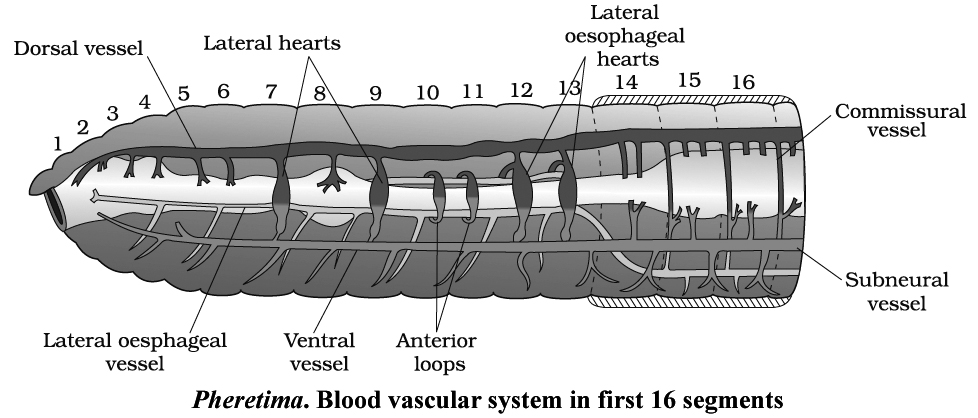
Supra-oesophageal vessel is unpaired and extends between 9th and 13th segments.
Sub-neural vessel
Hearts
There are 4 pairs of hearts with valves.
(a) Two pairs of lateral hearts, one pair in 7th and one pair in 9th segment
(b) Two pairs of lateral oesophageal hearts in 12 and 13th segments.
(c) There are 2 pairs of lateral loops in which valves are absent. One pair is in 10th and one pair is in 11th segment. Blood flows in upward direction in them.
EXCRETION
Concept Builder
Earthworm mainly removes the nitrogenous waste in the form of urea in soil. But when plenty of water is available earthworm is ammonotelic. So earthworm is both Ureotelic and Ammonotelic.
Excretory System
Excretory organs occur as segmentally arranged coiled tubules called nephridia. They deliver the wastes through a pore to the surface of body wall or into digestive tube.
(i) Three main types of nephridia are:
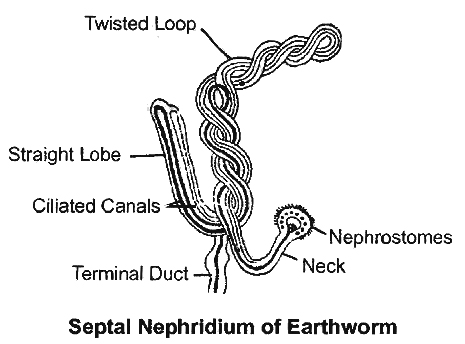
(a) Pharyngeal nephridia are situated in the segments 4,5 and 6. They open in the anterior part of alimentary canal, i.e., buccal cavity and pharynx. They are without nephrostome and are enteronephric type.
(b) Integumentary nephridia are scattered in the body wall. They are smallest, v-shaped, without nephrostome and are exonephric type. In clitellar segments they form forests of nephridia.
(c) Septal nephridia are the largest, attached to both faces of each intersegmental septum behind 15th segment.
(ii) Septal nephridia are the only nephridia with nephrostome or funnel. The terminal duct opens into septal excretory canal. These canals, in turn, open into two supraintestinal excretory canals. Septal nephridia are enteronephric, finally excretory products are poured into intestine. Enteronephric condition is an adaptation for the conservation of water or osmoregulation.
(iii) Excretory products of earthworm are urea (about 50%), ammonia (about 40%) and traces of creatinine. Earthworms are mainly ureotelic.
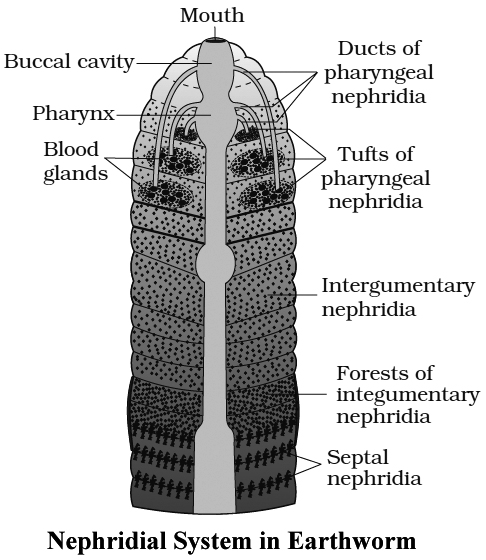
NERVOUS SYSTEM
It consists of central, peripheral and sympathetic nervous system.
CNS
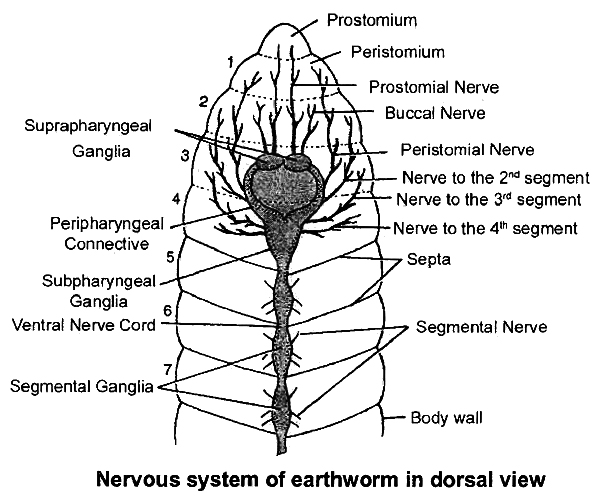
It consists of brain ring / circumpharyngeal ring and a ganglionated double ventral nerve cord.
Circumpharyngeal ring occurs in 3rd and 4th segment. It has a brain consisting of two suprapharyngeal ganglia, two circumpharyngeal connectives and a pair of subpharyngeal ganglia.
Ventral nerve cord arises from subpharyngeal ganglia, which is double, solid and bears paired ganglia in each segment.
PNS
It comprises nerves that extend from CNS to supply various parts. The nerves are mixed in nature.
Two pairs of nerves arise from brain and innervate prostomium and buccal cavity.
Nerves from circumpharyngeal connectives supply segments one and two.
Subpharyngeal ganglia send nerves to second, third and fourth segments.
Each segmental ganglion (actually paired) sends out 3 pairs of segmental peripheral nerves, one pair from anterior part and two pairs from posterior part.
They supply various structure in each segment. All the segmental nerves are mixed in nature, i.e. containing both sensory (afferent) and motor (efferent) nerve fibres.
Sympathetic Nervous System
Consists of various nerve plexuses present in the wall of alimentary canal.
SENSE ORGANS
Group of specialised cells found in skin and lining of buccal cavity.
Photoreceptors located in prostomium and dorsal epidermis. Perceive light intenSity with the help of phaosome (Optic organelle).
Thigmoreceptors located in ventral and lateral epidermis.
Olfactoreceptors located in lining of buccal cavity.
Gustatory receptors located in lining of buccal cavity.
RESPIRATION
Earthworm has no special respiratory organs.
Gaseous exchange takes place simply through the skin, which is thin and highly vascular.
Effective gaseous exchange takes place only when the skin is moist.
The skin is kept moist due to the damp earth, secretion of the mucus by the epidermal gland cell and oozing of coelomic fluid through the dorsal pores.
REPRODUCTION
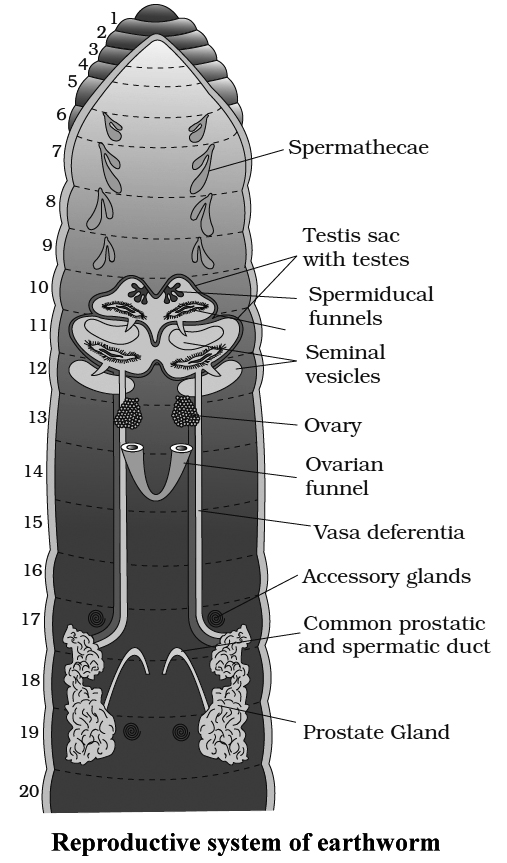
Earthwonn is hermaphrodite.
There are two pairs of testes present in 10th and 11th segments. They are surrounded by 2 testes sacs lying ventrally, one in the 10th and the other in 11th segment.
There are 2 pairs of seminal vesicles, one pair in 11th and the other pair in 12th segment.
Maturation of sperms occurs in seminal vesicles.
The testis sac of 10th segment communicates with the seminal vesicles of 11th segment and testis sac of 11th segment with seminal vesicles of 12th. From each testis sac, vas deferens carries the sperms up to 18th segment where they join the prostatic duct from prostate gland.
Four pairs of spermathecae are present, one pair in each ofthe6, 7, 8, and 9 segments. They receive and store the spermatozoa of another earthworm during copulation.
One pair of ovaries lies in 13th segment, which open through median aperture on 14th segment.
Accessory glands are present on the ventral surface of 17th and 19th segments, which open through the genital papillae. These are a part of male reproductive system.
Testes mature earlier (Protandrous).
Development is direct and there is no larval form.
Earthworm
The earthworm is a reddish-brown terrestrial invertebrate that lives in the moist soil's upper layer. They spend the day in tunnels created by burrowing and swallowing earth. Worm castings, or faecal deposits, are used to track them down in the gardens. Pheretima and Lumbricus are the most prevalent Indian earthworms.
(i) Morphology: Earthworms' bodies are long and cylindrical. The body is divided into over a hundred short, identical pieces (metameres about 100-120 in number). Along the longitudinal axis of the body, a dark median mid dorsal line (dorsal blood vessel) marks the dorsal surface. The presence of genital apertures distinguishes the ventral surface (pores).
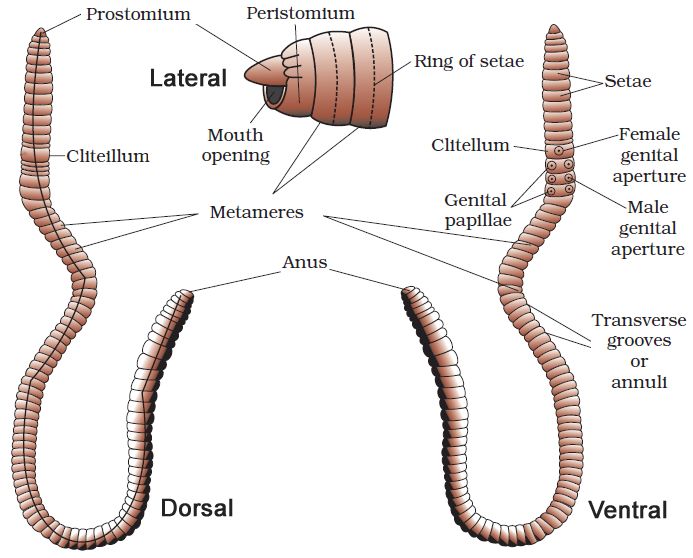
The mouth and the prostomium, a lobe that serves as a mouth cover and a wedge to force open soil crevices into which the earthworm may crawl, make up the anterior end. The role of the prostomium is sensory. The peristomium (buccal segment) is the first body segment and houses the mouth. A conspicuous dark band of glandular tissue termed clitellum covers segments 14-16 in a mature worm. As a result, the body is divided into three distinct regions: preclitellar, clitellar, and postclitellar. The ventrolateral sides of the intersegmental grooves, i.e. the 5th -9th segments, have four pairs of spermathecal openings. In the mid-ventral line of the 14th segment, there is a solitary female genital pore.On the ventrolateral sides of the 18th segment, there are two male genital pores. Nephridiopores are tiny pores that open on the surface of the body. Except for the first, last, and clitellum, each body segment has rows of S-shaped setae inserted in the epidermal pits in the middle. Setae can be retracted or expanded. Their primary function is movement.
(ii) Anatomy: A thin non-cellular cuticle covers the earthworm's body wall, which is followed by the epidermis, two muscle layers (circular and longitudinal), and an innermost coelomic epithelium. The epidermis is a single layer of columnar epithelial cells with secretory gland cells.
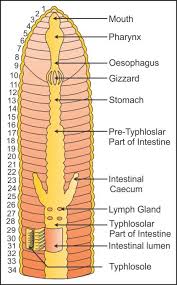
The alimentary canal is a straight tube that connects the first and last body segments. The buccal cavity (1-3 segments) leads into the muscular pharynx through a terminal mouth. The esophagus (5-7 segments) is a tiny, narrow tube that leads to the muscular gizzard (8-9 segments). It aids in the grinding of soil particles and rotting leaves, among other things. The stomach is divided into 9-14 parts. Earthworms eat decaying leaves and organic debris mixed with soil as nourishment.The humic acid in the humus is neutralized by calciferous glands in the stomach. The stomach begins at the 15th section and continues until the last part. On the 26th segment, a pair of short and conical intestinal caecae protrude from the gut. Except for the last 23rd-25th segments, the existence of an internal median fold of the dorsal wall called typhlosole is a distinguishing feature of the intestine after the 26th segment. This expands the absorption surface area in the gut. A little spherical opening called the anus connects the alimentary canal to the outside world. Digestive enzymes break down complicated meals into tiny absorbable components when the organic-rich soil moves through the digestive tract. These simpler molecules are absorbed and used through intestinal walls.
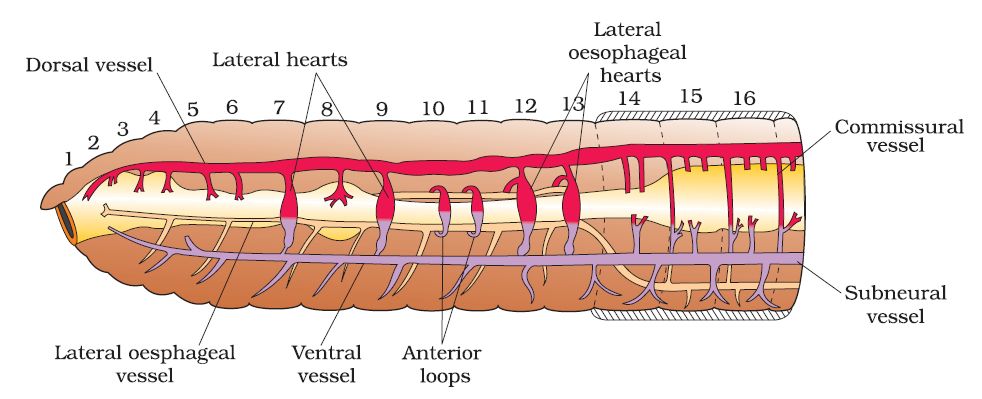
The blood vascular system of Pheretima is closed, consisting of blood arteries, capillaries, and the heart. Blood is restricted to the heart and blood vessels due to the closed circulatory system. Blood circulates in one direction due to contractions. The gut, nerve cord, and body wall are all supplied by smaller blood vessels. The 4th, 5th, and 6th segments all have blood glands. They manufacture blood cells as well as haemoglobin, which is dissolved in blood plasma. Blood cells are naturally phagocytic.
Earthworms do not have specific breathing apparatus. The wet body surface allows for respiratory exchange into the bloodstream.
Nephridia are segmentally arranged coiled tubules that make up the excretory organs (sing.: nephridium). There are three types of nephridia:
(i) Septal nephridia, which are present on both sides of intersegmental septa from segment 15 to the last that open into the intestine,
(ii) Integumentary nephridia, which are attached to the lining of the body wall from segment 3 to the last that open on the body surface, and
(iii) Pharyngeal nephridia, present as a three-paired outfit in 4th, 5th and 6th segment. The structure of these many nephridia is remarkably similar. The volume and composition of the bodily fluids are regulated by nephridia. A nephridium begins as a funnel, collecting surplus fluid from the coelomic chamber.The funnel connects to a tubular component of the nephridium, which transports wastes to the digestive tube through a pore in the body wall.
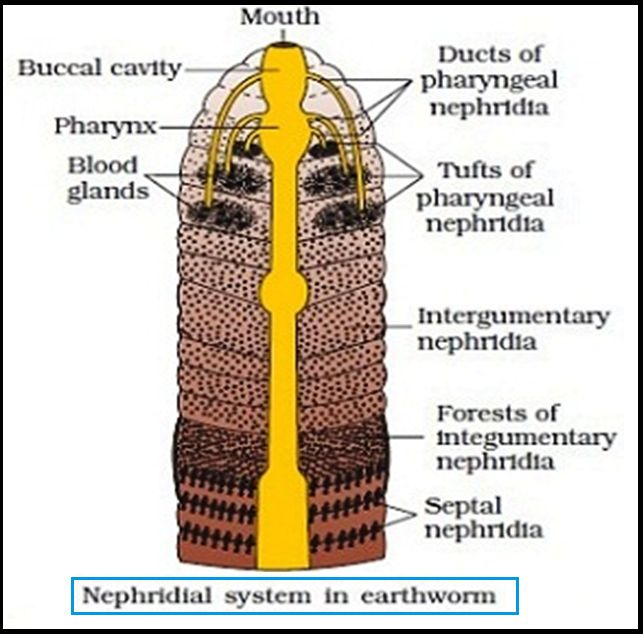
Ganglia are positioned segment-wise on the ventral paired nerve cord to represent the nervous system. In the front region (3rd and 4th segments), the nerve cord bifurcates, laterally enclosing the pharynx and dorsally joining the brain ganglia to form a nerve ring. The cerebral ganglia, along with other nerves in the ring, integrate sensory input and control bodily muscle responses.Although the sensory system lacks eyes, it does have light and touch-sensitive organs (receptor cells) that allow it to discern between light intensities and feel ground vibrations. Chemoreceptors (taste receptors) in worms are specialized to respond to chemical inputs. These sensory organs are found on the worm's front end.
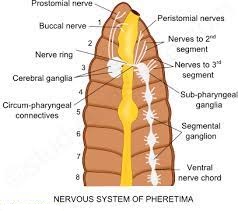
Earthworms are hermaphrodites (bisexual), which means they have both testes and ovaries. In the 10th and 11th segments, there are two pairs of testes. Their vasa deferentia connect to the prostatic duct at the 18th segment. In the 17th and 19th segments, there are two pairs of auxiliary glands, one pair in each.A pair of male genital holes on the ventrolateral side of the 18th segment access the outside the shared prostate and spermatic duct (vasa deferentia). In the 6th-9th segments, there are four pairs of spermathecae (one pair in each segment). During copulation, they receive and store spermatozoa. At the inter-segmental septum of the 12th and 13th segments, one pair of ovaries is attached. Underneath the ovaries are ovarian funnels that continue into the oviduct, unite, and open on the ventral side as a single median female genital hole on the 14th segment.
During the mating process, two worms exchange sperm. One worm must discover another worm, and they mate by exchanging spermatophores (packets of sperm) at opposite gonadal apertures.Cocoons made by clitellum gland cells contain mature sperm and egg cells, as well as nourishing fluid. Fertilization and development take place within the soil-deposited cocoons. The sperm cells within the cocoon fertilize the ova (eggs), which subsequently fall off the worm
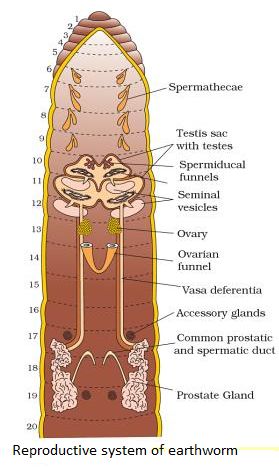
and land in or on the earth. The worm embryos are kept in the cocoon. Each cocoon generates two to twenty baby worms on average after about three weeks. Earthworms develop directly, without the formation of a larva. Earthworms are known as "farmer's friends" because they dig burrows in the soil and make it porous, which aids in plant root penetration and respiration.Vermicomposting is the method of using earthworms to increase soil fertility. They're also utilized as game fishing bait.

 ACME SMART PUBLICATION
ACME SMART PUBLICATION
